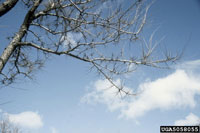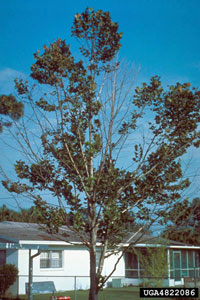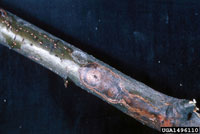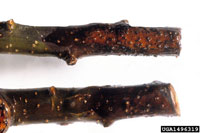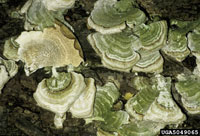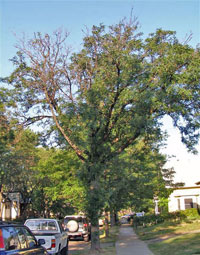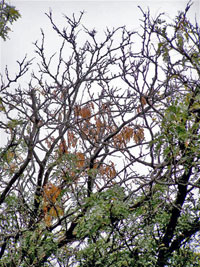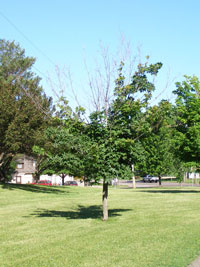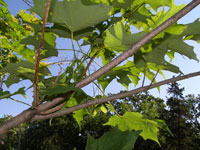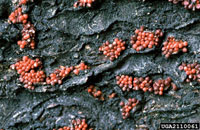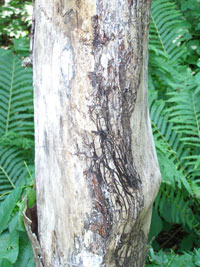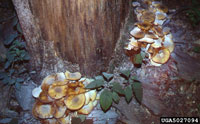Extension > Garden > Diagnose a problem > What's wrong with my plant? > Deciduous Trees > Hackberry > Dead branches in canopy
Hackberry > Branches/Trunk > Dead branches in canopy
1 of 7
Deicing salt injury
- Run-off salt kills roots which results in die-back of most branches
- Affected trees leaf out later than other non-infected trees
- Soil salt damage causes leaf edges or margins to appear burnt or scorched progressing toward the mid-vein
- Salt spray causes branch growth to become tuft-like (a.k.a. witches' broom)
- Damage most noticeable in spring and into the summer growing season
- More information on Deicing salts
2 of 7
Twig girdler
Oncideres cingulata
- Dead twigs may be scattered in canopy
- Chews around the outside of the twig, almost chewing through it
- Twigs can break off in wind and end up scattered on ground
- Damage seen in August and September
- Adult is about 9/16 inch long, grayish brown with scattered yellow spots, with antenna as long as its body
- More information on Twig girdler
3 of 7
Branch cankers
Botryosphaeria stevensii or Botryosphaeria spp.
- Scattered dead branches seen throughout canopy
- Leaves on random branches wilt, turn yellow then brown during the growing season
- Infected branches don't leaf out in spring
- Cankers are brown to black sunken areas on branch that may have cracked bark and discolored sapwood
- Common on trees stressed by drought, winter injury, wounds, insect feeding or other factors
- More information on canker
4 of 7
Sapwood rot
Cerrena unicolor
- Dead branches within the canopy
- Groups or rows of small (< 2 inches wide) semi-circle self fungi along killed branches or on the main trunk
- Shelf fungi are white to greenish grey and have concentric rings on the surface
- Common on trees with an open wound or crack
- Wood below fungal shelves is yellowish to white, crumbly and decayed; bark around fungal shelves is killed and often falls off
- More information on Heart rot
5 of 7
Ganoderma root and butt rot
Ganoderma spp.
- Canopy appears thin with few leaves and multiple dead branches
- Leaves are smaller in size and turn yellow earlier than normal
- Fungal conks, a semicircle shelf fungi, can be found from the base of the tree up to 3 feet high on the trunk
- Conks are reddish brown and shiny on top, white and porous underneath; a rim of white may be visible on the edge of
growing conks - Infected wood at the tree base is white, soft, stringy or spongy
- Infected trees frequently break or fall over in storms
- More information on Ganoderma root and butt rot
6 of 7
Coral spot canker
Nectria cinnabarina
- Dead branches and twigs, often first observed in early spring when no leaves form
- Or, wilting soon after leaves emerge in spring
- Sunken dark brown area on branch that is often cracked or has a ridge at the edge
- Raised cushion-like bumps on affected branches, may be cream to orange or red, turn black with age
- Common on trees stressed by drought, recent transplant or
other factors - More information on canker
7 of 7
Armillaria root rot
Armillaria spp.
- Infected trees have poor growth, dead branches in the upper canopy, undersized and/or yellow leaves
- Flat white sheets of fungal mycelia (mycelia fans) grow between the bark and sapwood at the base of infected trees
- Thick black, shoestring-like fungus can sometimes be seen under the bark, around roots and in the soil around the base of the tree
- Wood is decayed, white, soft and spongy, and this may extend from the base of the tree well up into the trunk
- Trees frequently break or fall over in storms
- Clusters of honey-colored mushrooms may grow at the base of the tree in fall
- More information on Armillaria root rot



